Use Any Of These 20 Options For Growing Under Trees Says Peter Lickorish
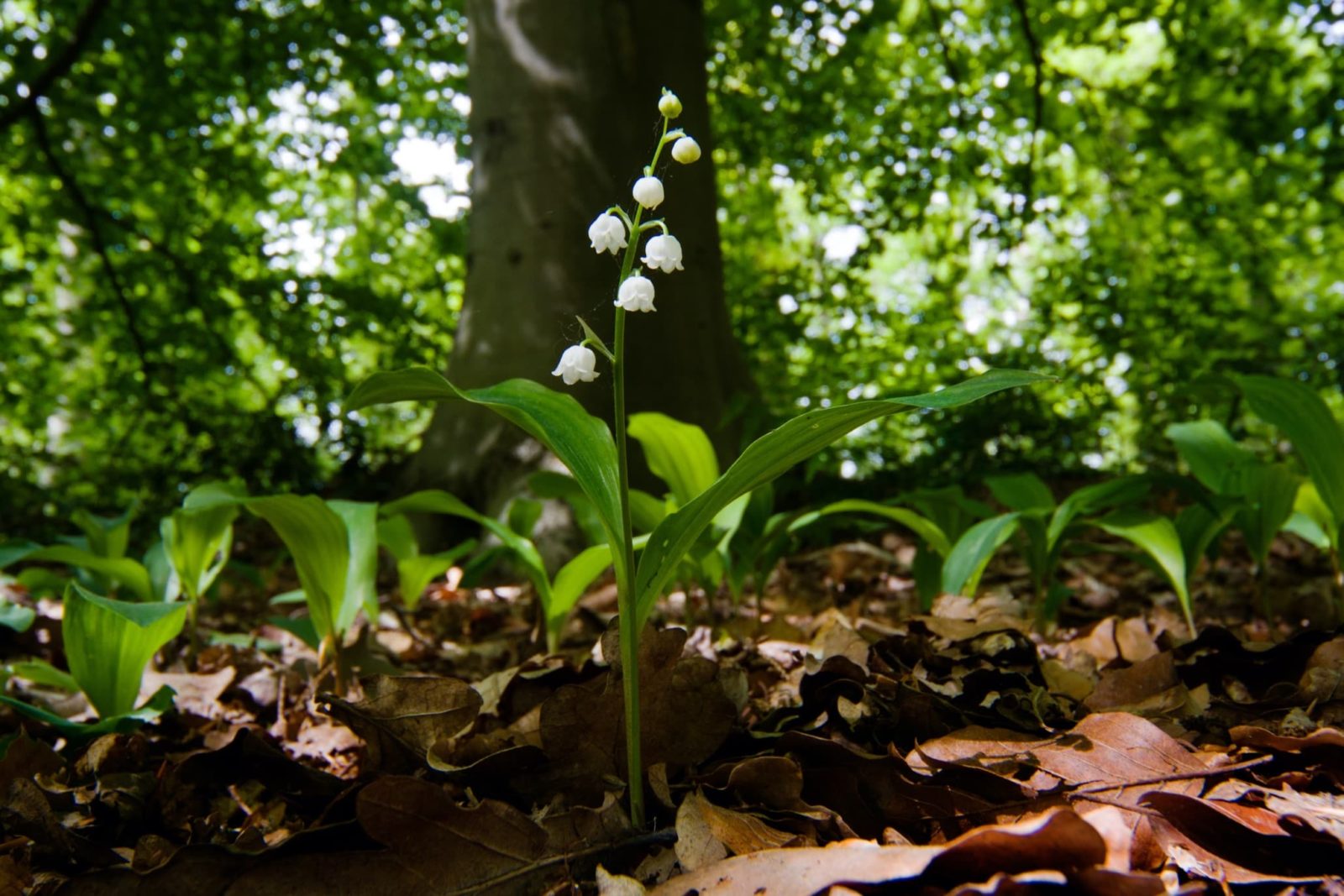
Reviewed By PETER LICKORISH

Peter is a Horticulture Lecturer and self-employed Horticulturist, with a passion for diverse areas of the industry - from garden design to the science behind plant growth and propagation. He has completed the Royal Horticultural Society’s Master of Horticulture (MHort) Award and lectures on RHS courses at Bedford College.
IN THIS GUIDE
- 1) Elephant Ears
- 2) Bleeding Heart
- 3) Daphne
- 4) Fuchsia
- 5) Plantain Lilies
- 6) Lily Of The Valley
- 7) Lungwort
- 8) Japanese Spurge
- 9) Periwinkle
- 10) Primrose
- 11) Garden Solomon’s Seal
- 12) Viburnum
- 13) Coral Bells
- 14) Spotted Deadnettle
- 15) Cranesbill
- 16) Columbine
- 17) Bluebells
- 18) Cyclamen
- 19) Foxgloves
- 20) Weigela
- Tips For Growing Under Trees
- References
Beneath the boughs of a tree may be one of the most challenging places to cultivate growth in your garden, but there are plenty of plants that will oblige.
Trees offer many benefits for a garden – their height and canopy can provide shade from the sun and shelter from the rain, alongside the obvious aesthetic advantages they bring.
However, those two practical selling points can become drawbacks when it comes to planting in their vicinity – since the lack of sunlight and moisture can inhibit the growth of many species.

“Some trees are more likely to have shallow roots, such as cherries and rowans, so planting under these is more of a challenge,” says Master Horticulturist Peter Lickorish.
“Damage to the roots may also cause suckering. To avoid drawing the eye too much away from the tree above, a simple mass of Hakone grass (Hakonechloa) can work really well to blanket the ground, if the canopy above is not too dense.”
Fortunately, there are still an abundance of options that will do well in such a situation.
The following list is largely suitable for growing under any kind of tree coverage, but it’s always best to consult the specific care instructions associated with your plant of choice should any doubt remain.
1) Elephant Ears

- BOTANICAL NAME: BERGENIA
- HARDINESS RATING: H7
- PREFERRED SUNLIGHT: FULL SUN / PART SHADE
- FLOWERING SEASON: SPRING
With their large, glossy leaves and sprouting clumps of colourful flowers, Bergenias are among the most loved flowers in any garden.
They can handle shade particularly well, while some strains can even benefit from poor quality soil by giving their leaves a reddish hue in autumn and winter.
What’s more, the fact that waterlogged soil and strong winds can harm their growth make sheltered planting ideal for Bergenia.
The rock provides that succour for the Elephant’s Ears variety pictured above, but a tree would do the job equally well.
2) Bleeding Heart

- BOTANICAL NAME: DICENTRA / LAMPROCAPNOS
- HARDINESS RATING: H6
- PREFERRED SUNLIGHT: PART SHADE
- FLOWERING SEASON: SPRING / SUMMER
The delicately pendulous blooms of bleeding heart (or dicentra, if you want to be more formal) make them an instant showstopper to any environment they adorn.
Although their heart-shaped blossoms are undoubtedly the main attraction, they’ll even provide intrigue when not in bloom through the intricately divided nature of their foliage.
While most species will do just fine under the boughs of a tree, some hybrids do demand more sunny locations, so check before planting.
3) Daphne

- BOTANICAL NAME: DAPHNE
- HARDINESS RATING: H4
- PREFERRED SUNLIGHT: FULL SUN / PART SHADE
- FLOWERING SEASON: WINTER / SPRING
Available in both deciduous and evergreen forms, daphne is a large genus of shrubs that are characterised by fragrant floral blooms and bright berries.
While almost all of them are easy to cultivate in your garden regardless of the conditions they’re placed in, some can grow up to 1m or more in height, which could interfere with the lower branches of the tree above them.
Since they often don’t take kindly to pruning, it’s advisable to opt for a smaller specimen when choosing a daphne for your garden.
4) Fuchsia

- BOTANICAL NAME: FUCHSIA
- HARDINESS RATING: H4
- PREFERRED SUNLIGHT: FULL SUN / PART SHADE
- FLOWERING SEASON: SUMMER / AUTUMN
Originally hailing from Central and South America, fuchsia plants have brightly coloured petals to attract the interest of hummingbirds in their native setting.1Breedlove, D., Berry, P., & Raven, P. (1982). The Mexican and Central American Species of Fuchsia (Onagraceae). Annals of the Missouri Botanical Garden. Retrieved March 22, 2023, from https://www.jstor.org/stable/2398791
Cross-breeding has produced a wide variety of different hues and combinations today, while their propensity to bloom right through summer makes them a firm favourite with UK homeowners.
They don’t like too much sun, making them an ideal candidate for a display beneath a tree, but they do demand moist soil at all times – so be sure to prevent their feet from drying out.
5) Plantain Lilies

- BOTANICAL NAME: HOSTA
- HARDINESS RATING: H7
- PREFERRED SUNLIGHT: PART SHADE
- FLOWERING SEASON: SUMMER
Not all plants are favoured for their flowering splendour.
Although some varieties of hosta do have blossoms, it’s certainly their foliage which is guaranteed to catch the eye.
With hundreds of different species available, you can plump for hostas with wide, variegated leaves or small, dainty alternatives, while their colours can range from lush deep greens to sullen greyish blues to even bright whites.
They can survive drought but will do best when given a hearty drink, so prevent them from drying out to achieve optimum results.
6) Lily Of The Valley

- BOTANICAL NAME: Convallaria majalis
- HARDINESS RATING: H7
- PREFERRED SUNLIGHT: FULL SHADE
- FLOWERING SEASON: SPRING
Despite its name, Lily of the Valley is perhaps more commonly found in woodland than valleys.
Given its capacity to grow in even the darkest recesses of a forest, it should have no problem handling a shady spot in your back garden.
The dainty blossoms look like they could serve as umbrellas for a fairy goddess, while the intoxicating fragrance they produce might suggest a fragile creature – but Lily of the Valley is hardy and fast-spreading, so it will provide adequate ground cover beneath your trees year after year.
7) Lungwort

- BOTANICAL NAME: Pulmonaria officinalis
- HARDINESS RATING: H6
- PREFERRED SUNLIGHT: FULL SHADE / PART SHADE
- FLOWERING SEASON: SPRING
Also known as pulmonaria, lungwort is so named for the shape of its leaves.
Nonetheless, don’t let its slightly distasteful moniker blind you to its charms.
Offering a colourful range of bee-friendly flowers atop silver-flecked foliage, this British native requires very little in the way of maintenance from you.
As you can see in the image above, it’s perfectly capable of flourishing when nestled in the base of trees, too.
8) Japanese Spurge
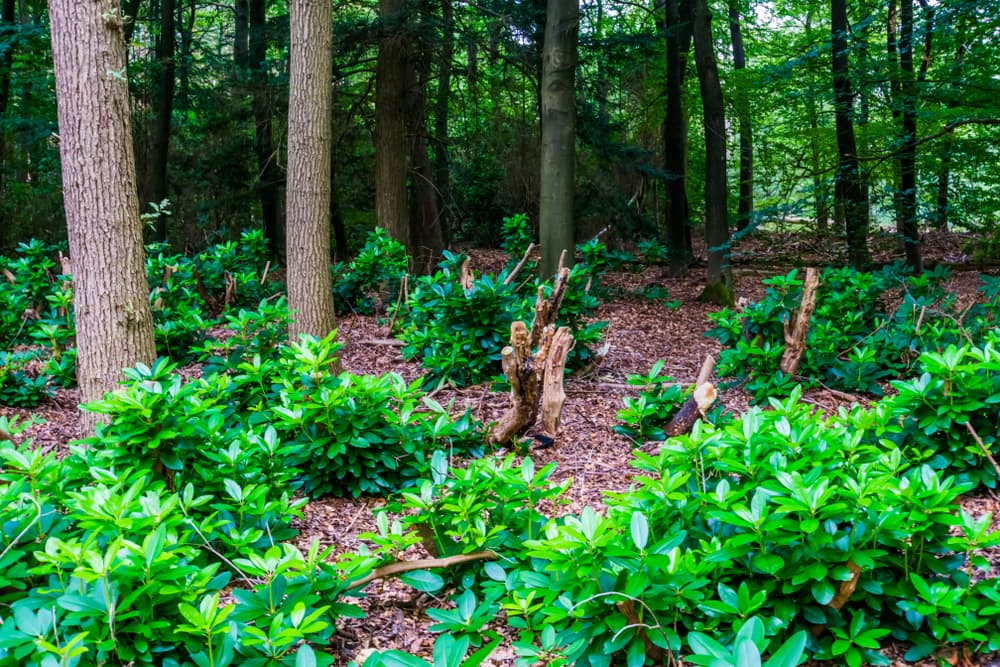
- BOTANICAL NAME: Pachysandra
- HARDINESS RATING: H5
- PREFERRED SUNLIGHT: FULL SHADE
- FLOWERING SEASON: SUMMER
Pachysandra comes in all shapes and sizes, from low but dense ground cover to clumped shrubs as pictured above.
What almost all varieties share in common, however, is the attractiveness of their foliage.
Flowers will appear during the warmer months on most specimens, but it’s the thick patina on its leaves that make it stand out from the crowd.
Pretty much all types of pachysandra will thrive in shaded conditions, though low-lying varieties may become invasive if not kept under control.
9) Periwinkle

- BOTANICAL NAME: VINCA MINOR
- HARDINESS RATING: H6
- PREFERRED SUNLIGHT: ANY
- FLOWERING SEASON: SPRING / SUMMER
Periwinkle is another plant whose progress must be closely monitored to avoid it spiralling out of control, since it just loves to spread out and invade the personal space of its neighbours.
Having said that, it’s the perfect choice for a shaded spot beneath a tree where the soil is so eroded that nothing else will grow.
Plus, the pretty flowers that it produces (in a range of colours, depending on the variety selected) will add intrigue come springtime.
10) Primrose

- BOTANICAL NAME: PRIMULA
- HARDINESS RATING: H7
- PREFERRED SUNLIGHT: FULL SUN / PART SHADE
- FLOWERING SEASON: WINTER / SPRING
The above shot of a single primrose flower pluckily shooting forth from the immediate vicinity of an aged and mossy tree is the ideal illustration of their determination and staying power in even the most adverse of conditions.
Indeed, it’s most at home in such situations, given that its natural habitat is the forest floor.
Some varieties will begin to bloom before almost anything else in your garden and provide months of aesthetic value.
11) Garden Solomon’s Seal

- BOTANICAL NAME: Polygonatum x hybridum
- HARDINESS RATING: H7
- PREFERRED SUNLIGHT: ANY
- FLOWERING SEASON: SPRING
Solomon’s seal, or Polygonatum x hybridum to give it its Latin name, is a favourite among English cottage gardens and wild woodlands.
It favours darker and cooler climes, meaning the nether reaches of a tree are the ideal spot for it, while the aesthetic attributes it brings are a huge draw for any horticulturist.
The foliage is impressive enough itself, with paired oval leaves lining its graceful, drooping stems.
However, the bell-shaped blooms, white in colour with a green tip, are what really sets it off – especially when paired with others on this list, such as Lily of the Valley or bleeding heart.
12) Viburnum

- BOTANICAL NAME: Viburnum davidii
- HARDINESS RATING: H5
- PREFERRED SUNLIGHT: FULL SUN / PART SHADE
- FLOWERING SEASON: SPRING
There is an incredibly diverse array of viburnums to choose from, with large deciduous shrubs and smaller evergreen perennials all on offer.
The pictured variety above is Viburnum davidii, which provides the holy trinity of blossoms, berries and interesting foliage all in one.
Dark leathery leaves provide the backdrop to tiny white flowers, while female specimens will supplement those twin advantages with metallic-looking berries when pollinated.
Best of all, they’ll grow under your tree with minimal encouragement.
13) Coral Bells
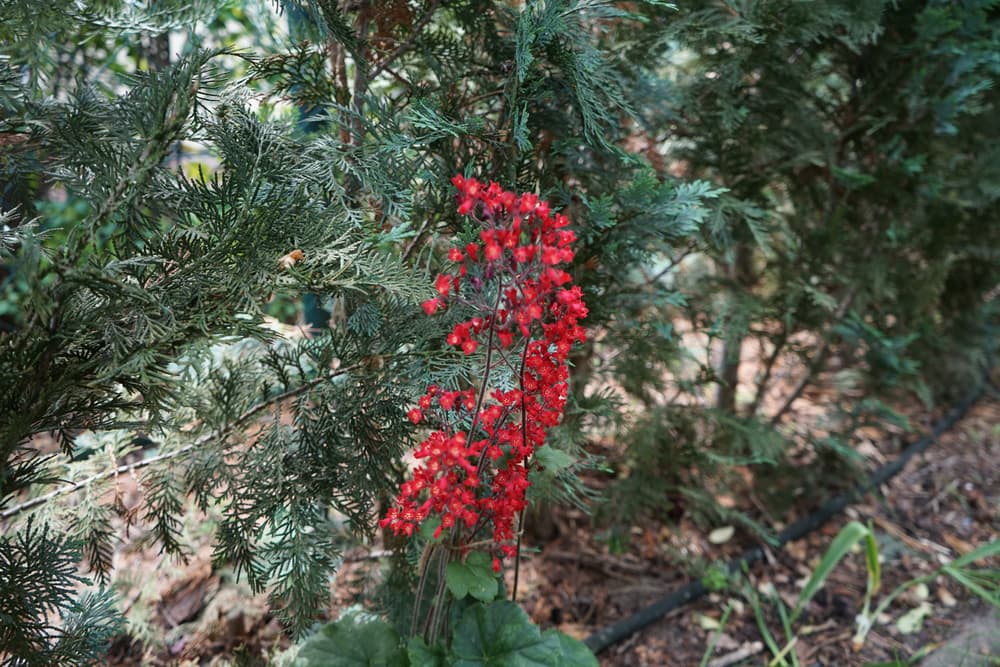
- BOTANICAL NAME: HEUCHERA
- HARDINESS RATING: H6
- PREFERRED SUNLIGHT: FULL SUN / PART SHADE
- FLOWERING SEASON: SUMMER
14) Spotted Deadnettle
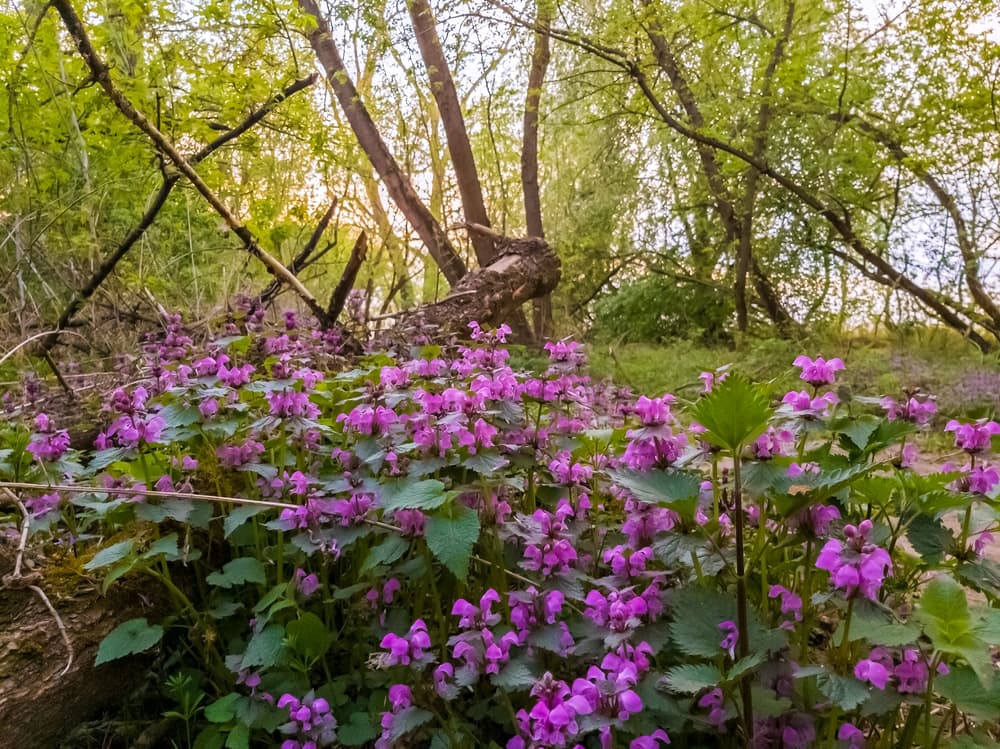
- BOTANICAL NAME: LAMIUM
- HARDINESS RATING: H7
- PREFERRED SUNLIGHT: FULL SHADE / PART SHADE
- FLOWERING SEASON: SUMMER
15) Cranesbill
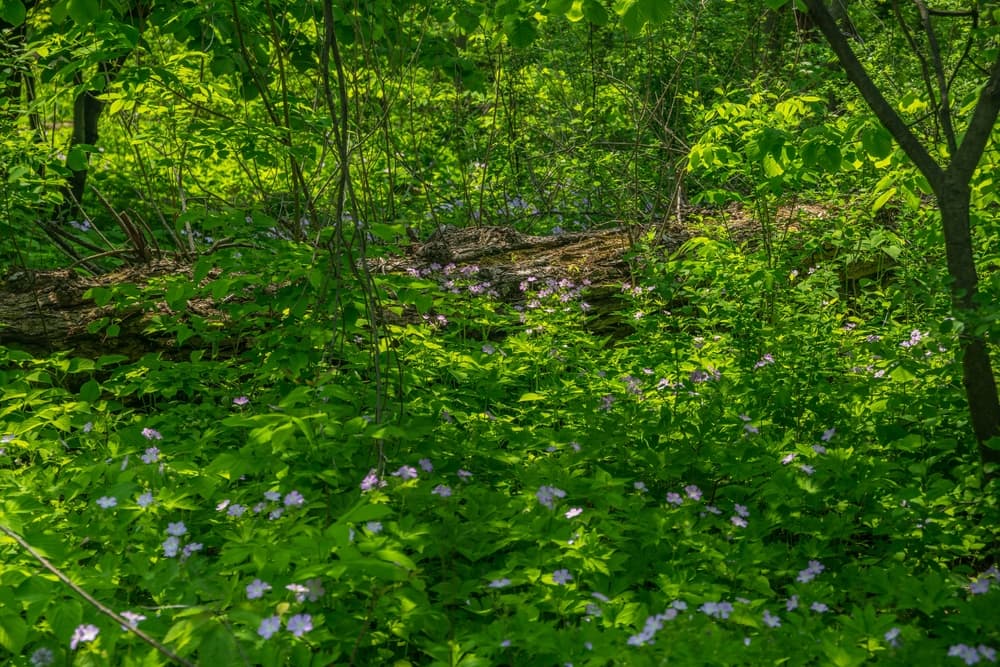
- BOTANICAL NAME: Geranium sylvaticum
- HARDINESS RATING: H7
- PREFERRED SUNLIGHT: FULL SUN / PART SHADE
- FLOWERING SEASON: SPRING / SUMMER
16) Columbine

- BOTANICAL NAME: AQUILEGIA
- HARDINESS RATING: H6-7
- PREFERRED SUNLIGHT: FULL SUN / PART SHADE
- FLOWERING SEASON: SPRING / SUMMER
17) Bluebells
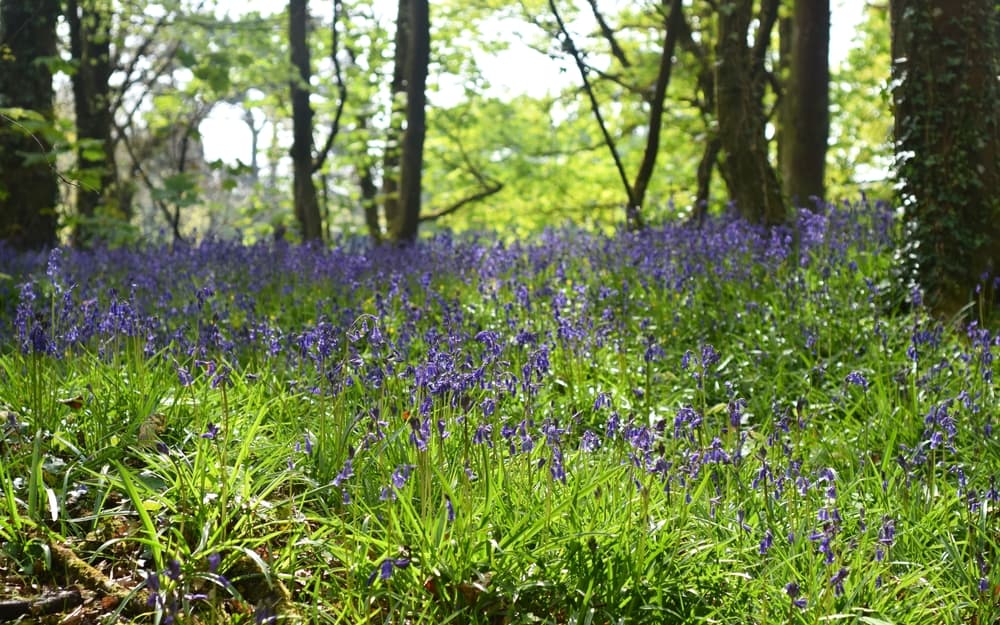
- BOTANICAL NAME: Hyacinthoides non-scripta
- HARDINESS RATING: H6
- PREFERRED SUNLIGHT: PART SHADE
- FLOWERING SEASON: SPRING
18) Cyclamen

- BOTANICAL NAME: CYCLAMEN HEDERIFOLIUM
- HARDINESS RATING: H5
- PREFERRED SUNLIGHT: FULL SUN / PART SHADE
- FLOWERING SEASON: WINTER / SPRING
19) Foxgloves

- BOTANICAL NAME: Digitalis purpurea
- HARDINESS RATING: H7
- PREFERRED SUNLIGHT: FULL SUN / PART SHADE
- FLOWERING SEASON: SUMMER
20) Weigela
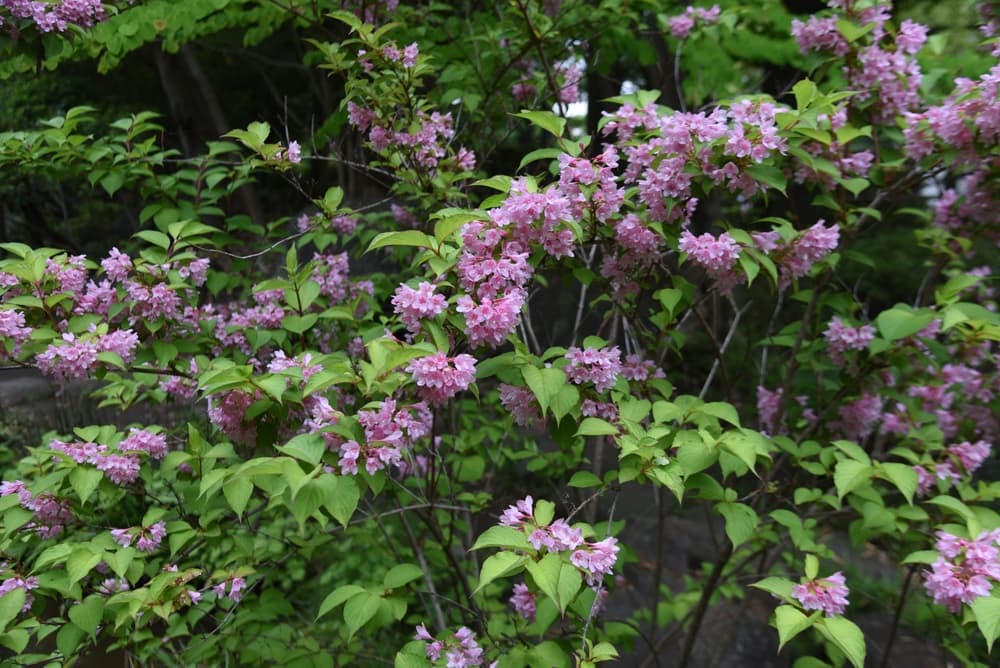
- BOTANICAL NAME: WEIGELA
- HARDINESS RATING: H6
- PREFERRED SUNLIGHT: ANY
- FLOWERING SEASON: SPRING / SUMMER
Tips For Growing Under Trees
The first factor which will influence your choice is whether the tree in question is evergreen, coniferous or deciduous.
The former will pose particular problems for planting beneath it, since the year-round coverage of the foliage means that the ground directly below is likely to suffer from very little sunlight exposure and excessively dry soil conditions.

What’s more, the proliferation of needles and other debris which often accumulates can make satisfactory growth of any plant – including grasses – a difficult endeavour.
But while it might be difficult, it’s certainly not impossible.
In that type of situation, it’s advisable to trim back the lower branches of the tree to ensure that some sun can filter through.
This is known as crown lifting.
You should also mulch the area beneath the tree with organic matter, leaving a buffer of around three feet between the trunk and your plants to ensure that its root system doesn’t interfere with their growth and vice versa.
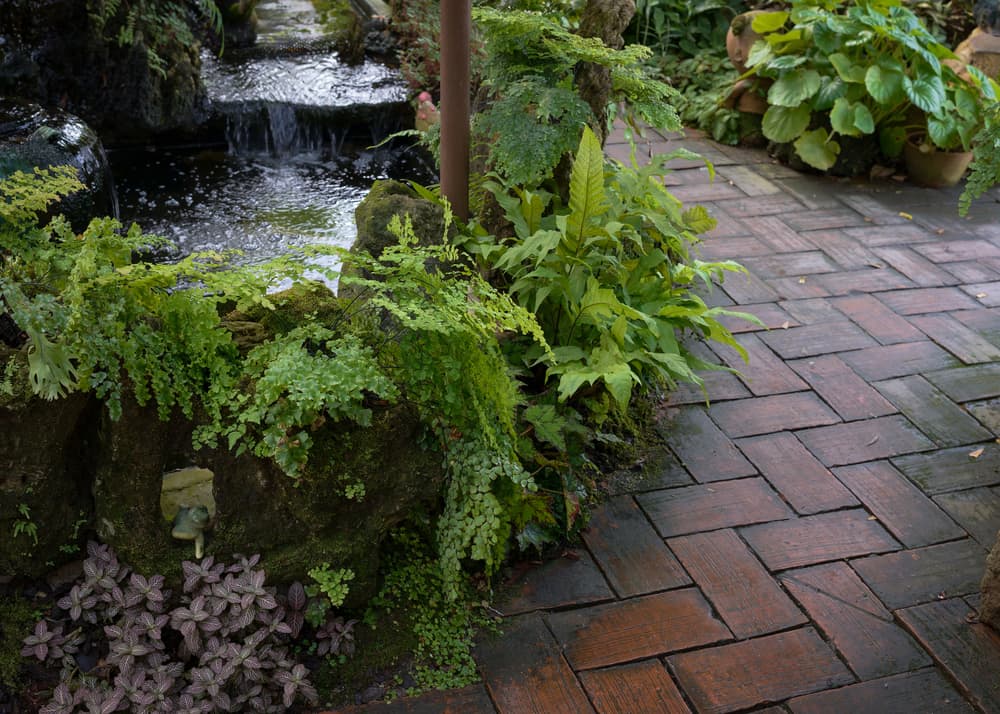
These precautions are sensible for any tree, regardless of whether it loses its leaves in winter or not.
Having said all that, there’s no reason to approach the cultivation of plants underneath trees with trepidation, since there is a wide array of varieties that can survive and even thrive in such conditions.
You might also want to check out our best ferns for dry shade – many of which will grow well under the shade of a tree.
References
- 1Breedlove, D., Berry, P., & Raven, P. (1982). The Mexican and Central American Species of Fuchsia (Onagraceae). Annals of the Missouri Botanical Garden. Retrieved March 22, 2023, from https://www.jstor.org/stable/2398791

